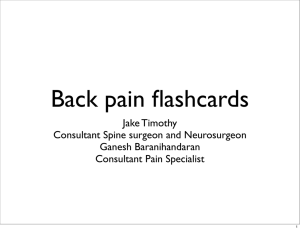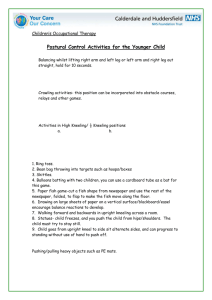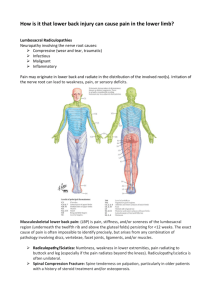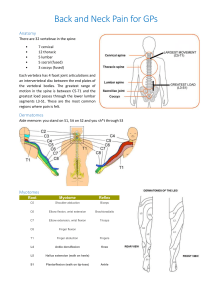Information and exercises following back surgery Decompression/
advertisement
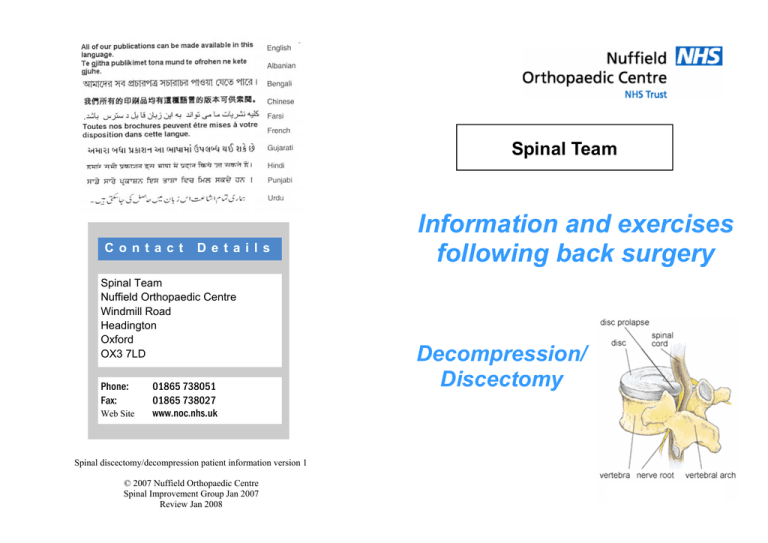
Spinal Team C o n t a c t D e t a i l s Spinal Team Nuffield Orthopaedic Centre Windmill Road Headington Oxford OX3 7LD Phone: Fax: Web Site 01865 738051 01865 738027 www.noc.nhs.uk Spinal discectomy/decompression patient information version 1 © 2007 Nuffield Orthopaedic Centre Spinal Improvement Group Jan 2007 Review Jan 2008 Information and exercises following back surgery Decompression/ Discectomy Welcome to the spinal team at the NOC. Together you and your spinal surgeon have decided that you should have an operation called a discectomy and/or decompression. This leaflet will explain what you need to do after your operation to help yourself recover as quickly as possible. Structure of the back Your spine is one of the strongest parts of your body. It is made of solid bony blocks (vertebrae) joined by discs to give it strength and flexibility. It is reinforced by strong ligaments and surrounded by large and powerful muscles that protect it. Having problems post operatively? A small number of people have a problem once they go home. You should contact your G.P if you have: • • • • Any deterioration in your bladder or bowel function. Any unusual leg pains or pins and needles. Any redness, oozing or discharge from your wound. Any increase in your temperature. Post operative follow up The spinal cord is the part of the nervous system which lies within the spine and is protected by it. Nerves branch out from the cord and carry messages to and from the brain. They allow us to feel temperature, pressure and pain. If a nerve is pressed by a disc or by bony changes then this can cause pain which may be felt in the back or in the leg or both. Benefits of having surgery • The main aim of surgery is to relieve the pressure on the nerve. This will mean that there is a good chance that the pain in your leg or arm will go or at least be much improved. If you have had pressure on the nerve for a long time or the nerve has become damaged by the pressure, you may not get a complete recovery of the nerve function. This means that you might always have some numbness in parts of the leg or arm, or weakness of some of the muscles. • Ssurgery does not always totally relieve the back pain, but often improves it. You will be reviewed by one of the orthopaedic doctors between 6 and 12 weeks post discharge. Many people do not require physiotherapy post operatively, however if you are particularly stiff or are having problems getting back to normal activities or work then physiotherapy can be arranged. USEFUL TELEPHONE NUMBERS NOC Main Switchboard - 01865 741155 Physiotherapy - 01865 738074 Occupational Therapy - 01865 737551 Spinal Secretaries - 01865 738051 Patient Advice & Liaison Service (PALS) - 01865 738126 1 14 Risks of having surgery If you have an exercise bike ♦ Start at a low resistance ♦ Build up gradually ♦ Standing with your arms by your Unfortunately, as with all operations, although every effort is made to avoid complications, surgery carries important risks. Some of these are mentioned below: • However carefully we remove the disc there is always a risk of recurrence. About 10 people out of 100, who have disc surgery, will get another disc prolapse after an operation (or indeed after an episode of pain without an operation). • Damage to a nerve happens in less than 1 person out of 100 having spinal surgery. This would mean that you might have numbness or weakness in part of your leg or arm. • Damage to the lining of the nerves (Dura) causing leakage of fluid occurs in less than 1 person out of 100. If this occurs during the surgery we can repair it. Sometimes we are not aware this has happened until after the operation and a second operation would be necessary to try and seal off the leak. Should this happen then you will have to stay in hospital for an extra few days. • Infection is always a risk with an operation. We give you antibiotics during the operation to aim to prevent infection Despite this it still happens in less than 1 out of 100 operations. • The nerves that supply your bladder, bowel and control your sexual function and sensation can also be damaged, either because of the disc prolapse or during surgery. This is a serious but much less common risk occurring in around 1 out of 500 disc operations. This would cause you to be incontinent of the bladder and/or bowel and to be unable to/or have difficulty with sexual function. side. Raise alternate arms above your head. Progression Repeat above with weights/tins of beans ♦ Brisk walking Progression Increase your speed or the distance 13 2 ♦ ♦ The operation These are routine operations which take approximately 90 minutes. They are often done through a microscope. This means that the cut is smaller, which results in quicker healing. Once recovered the spine remains strong and stable Lie on your front. If this is not comfortable, try putting a pillow under your tummy. Progression Push up to rest on your elbows. Discectomy If a disc has bulged and part of it is pressing on a nerve then this piece of the disc can be removed. It is not usually necessary to remove all of the disc. ♦ Standing. Hold on to something if you like. ♦ Raise one knee towards the opposite elbow Decompression This is the process of making more space around a nerve by removing a small amount of bone. ♦ Repeat with opposite leg. ♦ Use a step where there is a rail or something for you to hold on to ♦ Step up onto the step with one leg and then step back down with the same leg. ♦ Repeat with the other leg. Often these two procedures are done during one operation. After the operation After the operation you will wake up in the recovery room. Because of the anaesthetic it is necessary to monitor your blood pressure and breathing for a few hours. 3 ♦ Sit on a firm chair ♦ Stand up using your legs to push you up. Then sit down again. ♦ If this is difficult then start with a higher chair 12 Exercises The following exercises are designed to improve your spinal strength and mobility. Use the principles of pacing to judge where to start, then build up gradually. It is better to do a few exercises several times a day rather than all at once. ♦ Lying on your back with the knee’s bent ♦ Pull you tummy in and hold. Progression lifting your head and shoulders ♦ Lying on your back bend one leg and put your hands behind the knee. Your wound, just like any cut, may be a bit sore to begin with. But a back operation does not weaken your spine. It is just a matter of the wound healing and getting the moving parts and muscles working again. Pain relief You will have pain relief immediately after the operation and for as long as you need it afterwards. Pain control is important, particularly in the first few days and weeks. This is partly to make you comfortable but also to help you get going. You should not hesitate to use painkillers if you need them. It is best to take them regularly rather than letting the pain build up. You can safely mask the pain to get active—you will not do any harm. How soon can I get going? ♦ Use your arms to pull the knee towards your chest. ♦ Repeat with opposite leg. ♦ ♦ 11 The wound The operation takes away the cause of the pain. It is up to you to get back into condition and return to normal daily activities. Lying on your back bend one leg and put your hands behind the knee. Slowly straighten your leg until you feel tightness at the back of your leg. You may feel more tired than usual for a day or two as a result of the anaesthetic but surprisingly, you will be able to do a lot, fairly soon after the operation. People do vary in how long it takes them to get active. Things that affect this include: • • • • your age how fit you were before your operation how confident you are how much pain you have ♦ Repeat with opposite leg. You will need to start slowly and build up your stamina over a period of months by pacing yourself. ♦ If you prefer you can do this sitting You may feel some pain when you begin to do things again but this is normal and does not mean that you are doing any harm to your back. 4 Practical Tips Lying in bed Lie in what ever position you prefer, but any position for too long will be uncomfortable. The best thing is to change position regularly. Getting out of bed Roll onto your side, bend your hips and knees, swing your legs over the side push and up with your hands. It does help if the bed is higher than normal. You can progress to getting up normally over time. Washing Initially you will have to wash at a basin, with a flannel. This is to prevent the wound from getting infected. You may return to showering after a few days. Baths are best left until the wound is dry. Toileting You might find it difficult to go to the toilet at first. Don’t panic sit down, relax and take your time. It helps to take your painkillers about 20 minutes before. The sound of running water sometimes helps. Constipation is quite common, but nothing to worry about. It may just be the side effects of the painkillers. It helps to drink plenty of fluids. If need be, take a mild laxative. It might surprise you, but just walking helps. Dressing You may find it easier to get dressed while lying on the bed or whilst perching on the edge of your bed or a chair. Lots of people wear slip on shoes initially. Others put their shoes on by putting their foot on a chair . Bending forwards It will be easier to use your knees rather than your back Change position It is best to move before you stiffen up. Regularly changing your position and activity can help to reduce discomfort. 5 Return to Work Plan • What does your job involve? (e.g. sitting/ lifting/pushing/pulling/ driving/ bending/ walking/ reaching) __________________________________________________________________ • Which of these activities are not a problem? __________________________________________________________________ • Which of these activities are or may be difficult? __________________________________________________________________ • How can you make the activity easier? __________________________________________________________________ • When do you aim to return? __________________________________________________________________ • How many hours/days will you manage at first? __________________________________________________________________ • Who do you need to talk to, to arrange things? 10 Lifting The structure of the spine is strong enough to lift after the operation, the issue is whether you are fit enough. Most people will find they need to practice lifting to improve what they can mange. What is considered to be light or heavy varies from person to person and depends on: ♦ How fit they are ♦ What they are used to lifting ♦ How confident they are You can begin lifting light weights 1 week after the operation. It takes practice and time to get back to normal. Use pacing to gradually increase the amount you lift. As a guide, we would expect that you could lift heavier things by 6 weeks. Rest It’s alright to rest for short periods if you need to but try to alternate rest with gentle exercise and increasingly normal activity. Sitting You will find it easier to sit on something high like a stool initially. You will find it helpful to only sit for short periods initially. It is useful to have a walk each time you get up from sitting. You can sit in normal chairs once you are comfortable to do so, but this often takes a few weeks. Getting out of a chair To begin with you will find it easier to get out of a higher chair. It helps to move your bottom to the front of the chair, and use your hands to push up. Concerns regarding managing at home Lifting recommendations for heavier objects ♦ ♦ ♦ Think about your capability before you lift. Keep the load close to your waist. Ensure a good hold on the load. Work You need to get fit for returning to work as soon as possible. You do not need to wait until you are painfree. How long you are off work depends on your job. The following is a rough guide: • • • Desk jobs - 2 weeks Light lifting - 4 weeks Heavy lifting - 8 weeks (confirm this with your surgeon) There may be ways to make adjustments to your job that will let you get back earlier. It helps to make a plan for when and how you are going to return firstly to work and, secondly to your normal duties. 9 During your stay in hospital if you have any concerns about managing at home, please ask your nurse or physiotherapist to refer you to the occupational therapist. Housework (have a look at the activity chart) You can return to normal household activities as you feel able to do so. However, you may be more comfortable if: • You use pacing techniques to do tasks such as hoovering. • You sit on a high stool when ironing or preparing meals. Shopping Initially shopping may be more comfortable if: • You use 2 smaller bags or a backpack. • You use a shallow trolley rather than a deep one. Also • Some supermarkets have a “carry to car” facility to help with your shopping. • Try internet shopping. 6 Pacing activity Getting back to normal After the operation everyone builds up how much they do at different rates. The activity chart will give you a general feel for what is normal. It will take a few weeks for you to get back to most basic activities. Begin by getting out and about, exercising regularly, shopping, or meeting friends. Doing this will increase your confidence in your back. It will be a month or two before you can begin strenuous sports, and even then you must train and build up gradually. As a general rule, do things slowly at first and a little bit at a time. Establish a routine of activity that builds up gradually, step by step and day by day. Build up gradually The first thing to do is find out what you can manage at the moment. It helps to keep a record. and so on 20 min 15 min I can 11 min 8 min Sit for ——————minutes at present 6 min Walk for———————minutes at present. Lift ———————- kg/ llb from one table to another 5 min Sitting/ standing/ driving/cycling/ walking/ swimming/ running etc Stand for ————- minutes Once you know what you can do then you can work to improve it. To do this you need to do a bit less than you can manage (say 80%) but practice frequently and then build it up gradually by doing a bit more every few days. Good and bad days are normal You will find that you will have days when the pain is better or worse. This is normal. On a good day it is tempting to do more, but this is not a good idea, as it can lead to a flare up of your pain. It is best to keep to your activity plan even on bad days. Within two months you should be doing most everyday things fairly normally. Heavy physical activities come more slowly. You do not need to avoid lifting all together, just be sensible and leave the heavy stuff for a while. 7 Driving You may drive from 2 weeks after your operation as long as you are able to control the pedals and perform an emergency stop. It is best to inform your insurance company that you have had an operation. You can get into the car normally, but if this is difficult then you can try sitting down first and then putting your legs in. Similar to other activities you need to build up the length of the journey gradually. Stopping regularly and having a stretch or a walk will help. Sexual activity You back is not fragile, so the decision about when to have intercourse is really governed by when you feel comfortable to do so. This is likely to vary from person to person. The activity chart will give you a guide. 8


